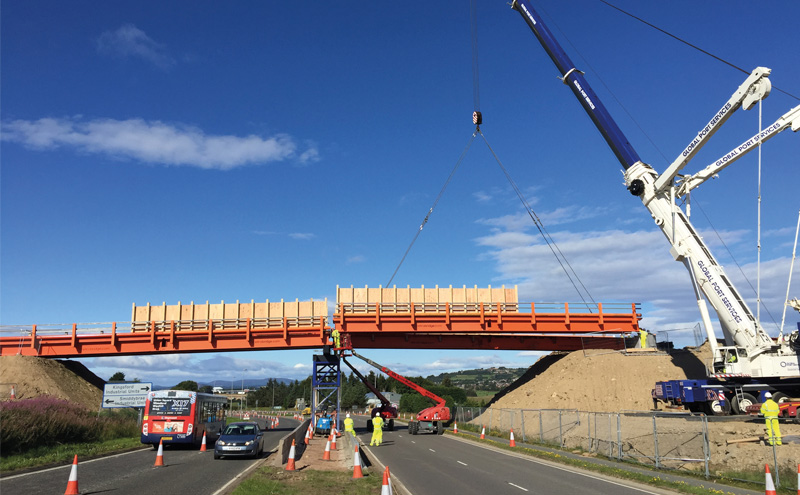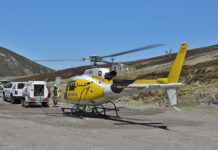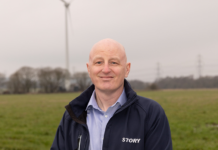
WITH Retro Bridge recently breaking ground on its 50th project in the UK – a 140-metre five span bridge in Lincoln – it is worth noting that just shy of half its completed UK projects to date have been carried out in Scotland.
Launched in 2013, Retro Bridge Ltd is part of the Netherlands-based Retro Bridge Group, which was founded in 2007 and has amassed over 12,500 tonnes of hire fleet bridging equipment since that time.
Alex Cole, managing director of Retro Bridge Ltd, said that the group grew from “a standing start” into “arguably the biggest bridge rental company in Europe” and puts this growth down to the group’s innovative product range.
“The guys who founded the business in 2007 had been in the industry for over 20 years. They looked at what was out there in terms of the best modular bridging systems and significantly improved on them,” Alex explained. “That’s why I believe our systems are the most innovative and best available on the market.”
Alex said there were a number of issues that had “plagued” temporary bridging for a long time which Retro Bridge has addressed.
“One of the biggest issues people have had with temporary bridges in the past is that when they were heavily trafficked, the decking came loose. If you use one of the more traditional systems on a busy road, you have to go a number of times to close the road and retighten the decks, which costs money and causes disruption.
“Another thing that had plagued temporary bridges for a long time was the lack of a vehicle parapet down each side of the roadway.
“There was a time where people would put temporary bridges up without parapets, which meant special measures had to be put in place to ensure the bridge trusses were not impacted by vehicles and the bridge did not incur damage or collapse.”
Alex said temporary bridges in the past could also be the cause of environmental incidents. He explained, “A lot of the older-style temporary bridge systems are made up with modular deck units which when installed have got cracks between, and as such, you can get oils from trucks or mud and other materials falling through the cracks, getting into the rivers or falling on cars travelling on a road below.
“Our Retro Light Bridge and Retro Heavy Bridge systems can be installed with additional measures used to ensure the deck is watertight and avoid such environmental contamination.”
He continued, “Those are generally the three issues that have plagued the temporary bridging market for years and which Retro Bridge’s founders were determined to resolve.
“The other main advantage of the resulting modular bridge systems is that temporary bridges can now be installed in about 20% of the time of a traditional Bailey or panel-type bridge, so speeds of installation and removal are massively improved. This is because much of the assembly is now taken off site into a factory controlled environment.”
Scotland has played a key role in Retro Bridge’s growth, with 24 completed projects in the region since 2013. The supplier’s fourth ever project in the UK was for a permanent 52-metre single span bridge near Inverness to replace an existing Bailey bridge that had reached the end of its useful life. This was quickly followed by an order for a permanent culvert Retro Beam Bridge replacement in Glen Lyon, Perth and Kinross.
Other Scottish projects have included temporary bridges to carry public road diversions in Selkirk and at Tweedsmuir, construction site haul road bridges to assist with earth moving operations in Aberdeen and New Cumnock, and permanent bridges for wind farms and overhead power line projects in Argyll and Bute and at the Grangemouth oil refinery.
Speaking on the challenges involved with Scottish projects, Alex said, “The challenges in remote areas tend to be the same; the thing with Scotland is that the sites tend to be a lot further away. If you’re doing something down in the countryside in Berkshire, it’s very easy to get plant locally. But if you’re working up on the Mull of Kintyre, for example, I discovered very quickly that there’s only one crane available locally – a small 45-tonne capacity mobile crane. Everything else has to come down from Glasgow or further afield, which has its challenges.”
Despite the challenges involved, Alex had high praise for the region. “We’ve found that people in Scotland have always had to work together to get things done, probably because of the remoteness of a lot of the sites.
“There’s an in-built partnership approach to projects in Scotland which contributes significantly to project successes and makes the region an enjoyable place to do business in.”











